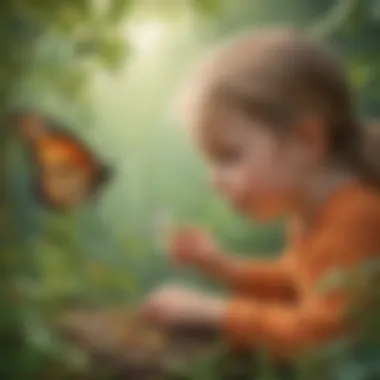Optimal Timing for Butterfly Kits: A Seasonal Guide


Intro
Butterfly kits offer a unique opportunity to witness the fascinating transformation of these insects. They allow families, educators, and young learners to explore biology in a hands-on way. To maximize the success of these kits, understanding the best time of year to start them is essential. This involves not only knowing the life cycles of butterflies but also considering the environmental conditions in different regions. By aligning butterfly rearing activities with local climate patterns and specific species' needs, one can enhance both educational outcomes and overall enjoyment.
Science Fun Facts
Butterflies are not just beautiful creatures; they embody a range of interesting facts. For instance, did you know that a butterfly’s lifecycle consists of four stages: egg, larva (caterpillar), pupa (chrysalis), and adult? This transformation is known as complete metamorphosis.
- Butterflies have taste receptors on their feet. This unique ability allows them to taste leaves where they might lay their eggs.
- The monarch butterfly migrates over 3,000 miles to escape cold weather, showcasing their impressive navigation skills.
- Some species of butterflies can see ultraviolet light, which helps them find nectar and mates more easily.
The world of butterflies is not only intriguing but also an excellent pathway for understanding ecosystems, biology, and the importance of conservation.
Discover the Wonders of Science
Educators and parents can leverage butterfly kits to teach children various scientific concepts. Here are a few engaging ideas:
- Exploring Butterfly Habitat: Discuss the different environments where butterflies thrive. Understanding these habitats fosters awareness about nature and conservation.
- Educational Videos and Animations: Utilize resources from platforms like Britannica that offer detailed visuals on butterfly life cycles.
- Interactive Learning Tools: Websites such as Reddit have communities where enthusiasts share experiences, photos, and insights on butterfly rearing.
Science Quiz Time
To further engage young learners, consider employing quizzes related to butterflies. Quizzes can cover:
- The stages of a butterfly’s life cycle.
- The habitat preferences of different butterfly species.
- The environmental factors that influence butterfly activity.
Interactive quizzes can be found in various educational resources online, providing an enjoyable way to reinforce learning.
Science Experiment Showcase
Hands-on experiments can significantly enhance the learning experience when using butterfly kits. Here’s a simple experiment:
Butterfly Observation Experiment
- Objective: To observe and document the behavior of caterpillars and butterflies.
- Materials List: Butterfly kit, notebook, pencil.
Step-by-Step Instructions:
- Set up the butterfly kit according to instructions.
- Observe the caterpillars daily, documenting any changes in your notebook.
- Once the butterflies emerge, continue observing their habits and nectar sources.
Safety Tips and Precautions:
- Always wash hands before and after handling the butterflies or caterpillars.
- Handle the caterpillars gently to avoid stress.
Understanding Butterfly Kits
Butterfly kits serve as a fantastic educational tool that allows individuals, particularly children, to engage with the fascinating world of caterpillars transforming into butterflies. Understanding butterfly kits is vital in this article as it establishes the foundation for how best to utilize these kits for both learning and enjoyment. By exploring their components and significance, families can make informed decisions on how to proceed with butterfly rearing.
Utilizing a butterfly kit offers multiple benefits. Firstly, it provides hands-on learning experiences. Observing the life cycle of butterflies in real-time aids in grasping biological concepts. Young learners can witness changes from egg to caterpillar to chrysalis and finally to a butterfly. Secondly, such kits can foster curiosity and a love for nature. Children can appreciate biodiversity and the essential role that butterflies play in ecosystems.
Moreover, practical considerations must not be overlooked. Factors like the timing of starting the kit, required supplies, and the caretaker’s commitment can significantly influence the educational outcome. These aspects can enhance or hinder the overall discovery experience. Likewise, understanding butterfly kits allows caretakers to anticipate potential challenges, equipping them to mitigate any issues that may arise during the process.
In summary, the inherent value of understanding butterfly kits lies in the educational and enjoyable experiences they facilitate. This section lays the groundwork for appreciating the components that comprise these kits and their applications.
The Life Cycle of Butterflies


Understanding the life cycle of butterflies is crucial for those engaged in butterfly kits. This knowledge directly informs the optimal timing for starting these kits, ensuring that individuals align their efforts with the butterflies' natural patterns. The life cycle consists of four primary stages: egg, caterpillar, chrysalis, and adult. Each stage presents unique characteristics and requirements, which affect the success of rearing butterflies.
Egg Stage
The egg stage is the beginning of the butterfly's life. Female butterflies lay their eggs on specific host plants. This choice is intentional, as the caterpillars will need to feed on these plants once they hatch. The eggs are small, often round or oval, and can vary in color depending on the species.
Timing is important here. Understanding the local climate helps determine when the eggs are likely to hatch. Warmer temperatures can shorten the incubation period, which typically lasts a few days to a week. Ensuring that host plants are available at the right time increases the chances of successful hatching.
Caterpillar Stage
After hatching, caterpillars emerge. This stage is marked by rapid growth and development. Caterpillars primarily focus on eating, and they consume a significant amount of foliage from host plants.
This stage can last from a few weeks to several months depending on species and environmental conditions. During this time, they undergo a series of molts, shedding their skin as they grow larger.
Proper monitoring of the caterpillars' growth is essential. Providing enough food and ensuring an appropriate environment are critical for their survival.
Chrysalis Stage
Once the caterpillar is fully grown, it enters the chrysalis stage. This stage is about transformation. The caterpillar finds a safe spot and forms a protective casing around itself. Within this chrysalis, the caterpillar undergoes significant changes to become a butterfly.
The duration of this stage varies considerably. Some chrysalises might remain in place for a few weeks, while others can take several months, especially if environmental conditions like temperature are not ideal. Understanding this stage's variability helps people know when to expect the adult butterflies to emerge.
Adult Butterfly Stage
Finally, the adult butterfly emerges from the chrysalis. During this stage, it needs time to pump fluid into its wings and allow them to dry before it can fly.
Adult butterflies are vital for pollination, contributing to the ecosystem. They typically live for a few weeks to several months, depending on the species. Understanding the adult stage emphasizes the importance of timing in rearing practices. For successful butterfly kits, encouraging the emergence of butterflies during suitable seasons enhances both the butterflies' behaviors and educational experiences.
Effective timing and understanding of these life stages can lead to improved success in butterfly rearing. Awareness of the life cycle enhances educational outcomes as families engage with nature.
Seasonal Considerations for Butterfly Kits
Understanding seasonal considerations is crucial for successful butterfly rearing. Different times of the year bring varied environmental conditions that directly influence the butterfly life cycle. Butterflies are ectothermic creatures, which means their body temperature and activity levels depend on the external temperature. Thus, knowing when to initiate butterfly kits can enhance both the survival rate of the butterflies and the educational experience of caretakers.
Moreover, each season provides unique opportunities for observation and learning. Engaging in butterfly rearing at the right time can increase children's curiosity about nature and the environment. This can foster a deeper appreciation for wildlife and ecological balance.
Spring: A Renewed Beginning
In spring, the natural world awakens from winter dormancy. Temperatures start to rise, and plants begin to bloom. This environment is ideal for initiating butterfly kits. Many butterfly species, such as the Monarch and Swallowtail, emerge during this season. The availability of fresh greenery provides essential food for caterpillars, making it a perfect time to start.
During spring, educators and parents can encourage kids to observe the changes in nature. This can include recording their findings in journals. Children may disucuss how the weather affects butterfly activity. Additionally, spring is a time of vibrant colors, which can inspire art and creativity.
Summer: Peak Activity
Summer is the peak season for butterfly activity. With warm temperatures and abundant food sources, butterflies are plentiful. Butterflies like the Painted Lady can be seen fluttering everywhere. Initiating kits during summer allows families to witness the notable stages of the butterfly life cycle.
In summer, children have the unique opportunity to engage in outdoor learning. Activities such as creating butterfly gardens can be beneficial. These gardens can attract butterflies and provide habitats for them. Kids can learn about different species, and seasonal changes, and even practice observational skills.
Autumn: Preparing for Hibernation
As autumn arrives, the days grow shorter and temperatures begin to drop. This signals butterflies to prepare for their winter rest or migration. For some species, like the Monarch, this involves long migratory journeys. Autumn is an important season for reflection on the butterfly life cycle. It provides a chance to learn about adaptation and survival.
Families can focus on understanding how the changing seasons impact butterflies. Observations about the behaviors of butterflies can be documented. Discussions about the concept of hibernation and migration can enrich learners’ knowledge of ecology.


Winter: Reflecting and Planning
Winter brings a time of dormancy for both butterflies and the ecosystems they inhabit. While butterflies themselves are not active, this season serves as an important period for reflection and planning. It’s an opportunity for families to review their past experiences with butterfly kits. Parents and children can discuss what worked well and what could be improved.
Additionally, winter is the ideal time for research and planning for the next spring's butterfly-kitting activity. Families can explore educational resources and read about local butterfly species. This preparation can enhance the upcoming butterfly rearing experience. Parents might also engage children in discussions about the importance of caring for the environment.
Understanding seasonal shifts can profoundly impact the success of butterfly kits and the educational value for children.
Local Climate and Its Impact
Understanding the local climate is essential when it comes to butterfly kits. The climate not only influences the butterfly life cycle but also affects when you should start your butterfly kit. Depending on the temperature and precipitation patterns in your area, times of activity can shift significantly. Not all butterflies thrive in the same conditions, and some species are more sensitive to environmental changes than others. Recognizing these factors helps ensure a successful experience while raising butterflies.
Understanding Regional Variations
Each region has distinct weather patterns. For instance, butterflies in warmer areas tend to emerge earlier in the spring than those in cooler climates. In southern regions, where temperatures are milder, it may be suitable to begin butterfly kits as early as March. Conversely, in northern climates, the ideal time might not be until late April or even May. Knowing your local temperature trends helps you pinpoint the best time to start your kit.
Furthermore, humidity levels can also play a crucial role. High humidity may make it easier for certain butterfly species to thrive, while dry conditions could hinder their growth. Monitoring local forecasts and understanding long-term climate trends will provide valuable insights when scheduling your butterfly projects.
Common Butterflies by Region
Different regions host various butterfly species. Here are some common butterflies you might encounter based on geographic area:
- Eastern United States: Monarch, Swallowtail, Painted Lady
- Western United States: Buckeye, Common Yellow Swallowtail, Red Admiral
- Southern United States: Zebra Swallowtail, Gulf Fritillary, Longwing
- Northern United States: Mourning Cloak, Common Buckeye, Spring Azure
By knowing which butterflies are common in your region, you can better plan your kit. Each species has its unique life cycle and optimal conditions for development. This knowledge allows for a more tailored approach, improving the chances of a fruitful rearing experience.
Takeaway: Recognizing local climate and butterfly species can help you determine the right time for starting your butterfly project. This knowledge lays the foundation for a successful and engaging educational experience.
Educational Benefits of Timing
Deciding when to start butterfly kits is not just about choosing a season. Timing plays a vital role in enhancing the educational experience for children and families. Understanding the educational benefits can allow caregivers to better appreciate the learning journey involved in raising butterflies. This section will break down how timing positively influences learning and engagement with nature.
Enhanced Learning Opportunities
Selecting the right time of year for butterfly kits opens multiple avenues for learning. Different seasons present various butterflies, and engaging with these species can provide children with real-life lessons on biology and ecology. For instance, a spring start allows for the observation of the life cycle from the beginning when butterflies emerge from eggs, while summer offers active caterpillar development.
Many educational frameworks emphasize experiential learning, which is best achieved through real-world observation. When children engage with butterflies from the egg stage to becoming adults, they grasp concepts like metamorphosis and the importance of ecosystems. Involving children in this process fosters critical thinking skills and motivates them to ask questions and seek answers.
An ideal timing can incorporate outdoor educational activities. For example, families can plan trips to local parks or butterfly conservatories during the peak seasons. These experiences could enhance classroom teachings, making biology lessons more tangible and relatable.
Engagement with Nature
Timing also plays a crucial role in fostering a sense of connection with the natural world. When families start butterfly kits during optimal seasons, they encourage children to observe and appreciate the environment around them. This relationship with nature can significantly affect children's attitudes towards conservation and biodiversity.
Children who actively engage with nature are more likely to develop a sense of responsibility towards protecting it. Observing butterflies firsthand allows them to witness the impacts of environmental changes, like habitat loss and climate shifts. Real-world experiences can often lead to deep-rooted values in children, making them more empathetic stewards of the environment.
By choosing the right time to start butterfly kits, families can create a rich learning context that connects physiological concepts with hands-on experiences in the wild. These interactions not only reinforce academic knowledge but also shape children's overall character and leadership qualities.
"The best way to inculcate a love for nature is not through books but through direct observation."
Best Practices for Successful Butterfly Kits
Understanding the best practices for successful butterfly kits is essential for anyone interested in raising these beautiful insects. When you follow effective methods, the entire experience becomes more enjoyable and educational. This section delves into the specifics to ensure you have everything you need to help caterpillars transform into butterflies.


Choosing the Right Kit
Selecting the right butterfly kit is crucial for a successful rearing experience. There are many options available, but not all kits are created equal. Look for kits that provide everything necessary for the complete life cycle. A good butterfly kit should include:
- Caterpillar habitat: This is where the caterpillars will grow and change. It should be spacious and have good ventilation to prevent mold and ensure healthy development.
- Butterfly food: Ensure the kit comes with the proper type of food for the caterpillars you choose.
- Life cycle guidance: Some kits offer detailed instructions and educational materials. These can help in understanding what to expect at each stage.
Take into account the age and attention span of the children who will be participating. Some kits are more suitable for younger children, while others may be more complex and suitable for older kids or adults. The Amazon Butterfly Garden and Insect Lore Butterfly Growing Kit are popular options known for their quality and educational value.
Creating a Suitable Environment
Creating an appropriate environment is equally important when raising butterflies. The habitat you provide can influence the butterflies' health and growth significantly. Here are some considerations to ensure a suitable environment:
- Temperature: Butterflies require warmth to thrive. An ideal range is between 70°F and 85°F (21°C to 29°C).
- Humidity: Maintain a humid environment in the habitat. Adding water-soaked sponges or misting the area can help.
- Light: Adequate lighting is vital. Natural light is best since it mimics their habitat outside. However, be careful of direct sunlight as it can overheat the environment.
- Safety: Ensure that your selected space is safe from pets and other potential hazards.
"A proper setup enhances the chances of successful metamorphosis, ensuring that children witness the complete transformation firsthand."
The success of your butterfly kit experience hinges on these best practices. Following the advice mentioned above will guide you towards raising healthy butterflies, enriching the educational journey for all involved.
Navigating Challenges in Butterfly Rearing
Butterfly rearing can be a fulfilling yet challenging experience. Understanding the potential difficulties involved is essential for successful butterfly kit management. Parents, educators, and children can benefit greatly from anticipating these hurdles. This makes it easier to enjoy the process of learning about these fascinating insects.
Preventing Common Issues
To foster a thriving butterfly environment, several common problems must be addressed proactively. These include:
- Mold Growth: High humidity can promote mold, harming caterpillars. It's critical to maintain proper airflow and not overcrowd the container.
- Nutritional Deficiency: Each butterfly species consumes certain types of food. Providing the wrong diet can result in stunted growth. It is vital to research the specific dietary needs of caterpillars.
- Temperature Fluctuation: Extreme temperatures can affect development. A stable climate in terms of heat is necessary for the caterpillars to thrive.
- Pests: Mites, ants, or parasitoids can invade butterfly kits, posing a threat. Regular inspection is key to their management.
By recognizing these issues before they happen, one can create a nurturing habitat conducive for growth.
Understanding Potential Outcomes
Failure to prevent issues can yield various outcomes, some expected and some not. It is important to consider multiple scenarios when raising butterflies. Some outcomes include:
- Successful Emergence: If conditions are ideal, caterpillars will form chrysalises and successfully emerge as butterflies, leading to an engaging learning experience.
- Increased Awareness: Challenges encountered during rearing can foster a deeper understanding of nature and the life cycle. Observing these events can inspire curiosity and scientific inquiry among children.
- Loss of Specimens: Unfortunately, not every caterpillar reaches adulthood. Understanding this risk teaches valuable lessons about life cycles and ecosystems.
"Every challenge faced is an opportunity for learning. Understanding the potential outcomes enhances the educational experience around butterfly kits."
In summary, navigating challenges in butterfly rearing prepares individuals for success. It incorporates proactive measures alongside awareness of potential outcomes. Engaging with these insects reveals important ecological insights, enhancing educational interactions.
Concluding Thoughts on Timing for Butterfly Kits
Timing plays a crucial role in successfully using butterfly kits. The connection between the right season and specific butterfly species can significantly influence the educational experience. This article explores important factors that determine when to start butterfly kits.
Revisiting Key Points
Understanding the life cycles of butterflies is essential. Each stage, from egg to adult, has specific environmental needs. Seasonal variations impact these needs, making timing critical.
- Spring is often seen as the best time to start. Caterpillars thrive when they have plenty of food sources available. This is a time when many plants bloom, providing ideal conditions.
- Summer represents peak growth and activity. Butterflies flourish, becoming more visible. This is also a popular time for outdoor education, making it engaging for children.
- In Autumn, as the weather turns cooler, preparing the kits for hibernation becomes vital. Knowledge of the changes can enhance the learning experience.
- Winter encourages reflection and planning. It allows families to review past experiences and learn from them.
This cycle teaches patience and care, important values for young learners. By revisiting these points, readers can acknowledge how each season contributes to a meaningful experience with butterfly kits.
Encouraging Future Endeavors
Looking to the future, there are several ways to maximize the enjoyment of butterfly activities. Families should consider
- Continuing Education: Explore new species and their adaptations. Books and online resource can enhance understanding.
- Community Involvement: Join local butterfly conservation groups. These communities often plan events centered around butterfly observations and education, allowing families to connect with others who share similar interests.
- Experimental Approaches: Try initiating butterfly kits in different seasons to observe variations in outcomes. This not only enhances understanding but forms a stronger connection with nature.
The experience with butterfly kits isn't just about raising butterflies; it’s an opportunity to cultivate a deeper appreciation for life cycles and environmental needs.







